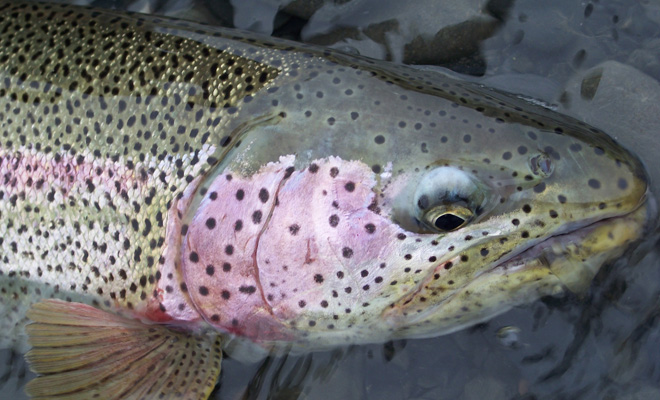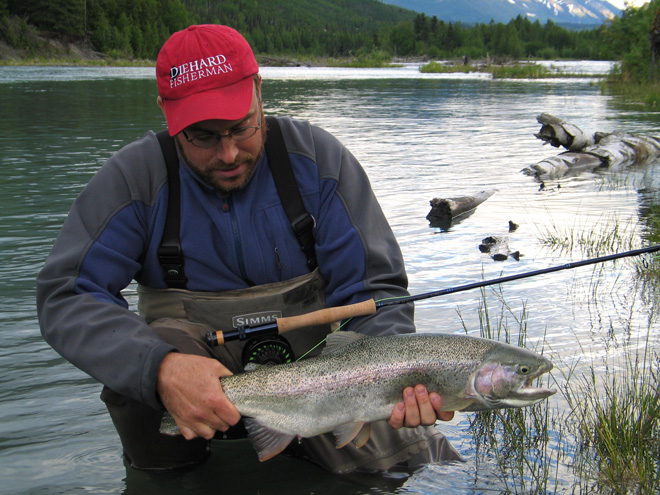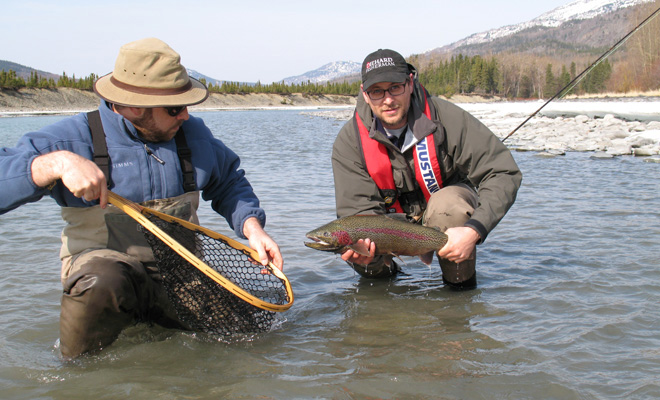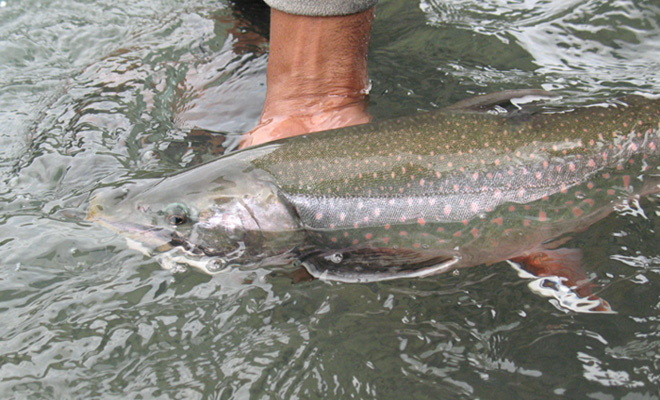
Rainbow Trout & Dolly Varden
Chile. New Zealand. Katmai. Destinations that quickly bring visions of giant trout when mentioned amongst trophy anglers. Add to this elite list the Kenai River, a place that comes alive with gorging rainbows and aggressive Dolly Varden char every late summer and fall. Somewhat of a hidden treasure that is often overshadowed by its “other” trophy fishing opportunities, the Kenai’s trout fishing can be truly world-class. In fact, if one is looking for that holy grail of a rainbow (30 plus inches) there may not be a more affordable, easier access and higher odds fishery on the planet!
 Being resident fish (as opposed to androgynous salmon), huge trout are present 24/7 in the Kenai River. However, like all fishing, some time periods offer better fishing than others. The first peak time is the short window immediately following the early June opener, where hungry post-spawn trout momentarily let their guard down to binge after a long, cold and icy winter. The second time to fish for trophy trout is the late summer when main-stem kings begin spawning. The third and most popular time to fish for the Kenai’s big trout is in the fall when hundreds of thousands of reds begin to spawn. Turned on by a total abundance of food, in the form of loose eggs and (later) rotting salmon flesh, these aggressive trout put on weight fast.
Being resident fish (as opposed to androgynous salmon), huge trout are present 24/7 in the Kenai River. However, like all fishing, some time periods offer better fishing than others. The first peak time is the short window immediately following the early June opener, where hungry post-spawn trout momentarily let their guard down to binge after a long, cold and icy winter. The second time to fish for trophy trout is the late summer when main-stem kings begin spawning. The third and most popular time to fish for the Kenai’s big trout is in the fall when hundreds of thousands of reds begin to spawn. Turned on by a total abundance of food, in the form of loose eggs and (later) rotting salmon flesh, these aggressive trout put on weight fast.
More specifically, mid August can be very good, late August hot and September simply off-the-charts by many trout fishing purists standards, with 25-100 fish days common and multiple ‘bows of 24-28 inches landed daily. And for those anglers who love to dream, don’t think that these giant native trout quit growing at thirty inches; each fall a lucky angler or two will catch and release 33-36″ trout that would approach twenty pounds if weighed on a certified scale!
 Effective mid-summer trout fishing lures will range from everything from diving Wiggle Warts to flies like egg sucking leaches, flesh flies and muddler minnows. As previously mentioned, in the fall these resident trout are packing on necessary weight by pigging out on flesh and eggs, thus choosing a lure is pretty easy: single egg imitations in the form of glow bugs and beads do the trick. Don’t assume, however, that these aggressively feeding trout will strike anything round and red. On the contrary, to be consistently successful, an angler must “match the hatch” by duplicating the exact size and shade of the spawn, according to whichever salmon species is currently spawning and what stage the process is in. Fooling immature rainbows and psycho dollies is one thing, but giant trophy rainbows grow extremely slow in our cold waters, which means that a 10-12 year old trout has seen every bead imitation made and can easily differentiate between a real egg and a poorly thought out replica. These older age-class fish are extremely educated, which is why serious trout fisherman and professional guides often carry hundreds of custom hand painted beads to match every condition and stage of the spawn.
Effective mid-summer trout fishing lures will range from everything from diving Wiggle Warts to flies like egg sucking leaches, flesh flies and muddler minnows. As previously mentioned, in the fall these resident trout are packing on necessary weight by pigging out on flesh and eggs, thus choosing a lure is pretty easy: single egg imitations in the form of glow bugs and beads do the trick. Don’t assume, however, that these aggressively feeding trout will strike anything round and red. On the contrary, to be consistently successful, an angler must “match the hatch” by duplicating the exact size and shade of the spawn, according to whichever salmon species is currently spawning and what stage the process is in. Fooling immature rainbows and psycho dollies is one thing, but giant trophy rainbows grow extremely slow in our cold waters, which means that a 10-12 year old trout has seen every bead imitation made and can easily differentiate between a real egg and a poorly thought out replica. These older age-class fish are extremely educated, which is why serious trout fisherman and professional guides often carry hundreds of custom hand painted beads to match every condition and stage of the spawn.
 Rainbows and dollies reside in the entire Kenai River system, but the highest density of trout occurs in theupper reaches, which naturally is where most trout anglers choose to fish. The short drift from Kenai Lake to the public access just above the Russian River (called Sportsman’s Landing) can offer good trout fishing at times. Over the years, the section just below this, from Sportsman’s to Jim’s Landing has become the most popular water for those seeking good trout action. Below that lies the Kenai canyon, a beautiful but logistically challenging, boulder strewn class III gorge with no roadside access and thus limited fishing pressure. Arguably the prettiest section of the Kenai, the canyon always seems to hold some giant trout. For those boaters experienced enough to challenge it and willing to motor across Skilak Lake at the end of the day to reach their take out.
Rainbows and dollies reside in the entire Kenai River system, but the highest density of trout occurs in theupper reaches, which naturally is where most trout anglers choose to fish. The short drift from Kenai Lake to the public access just above the Russian River (called Sportsman’s Landing) can offer good trout fishing at times. Over the years, the section just below this, from Sportsman’s to Jim’s Landing has become the most popular water for those seeking good trout action. Below that lies the Kenai canyon, a beautiful but logistically challenging, boulder strewn class III gorge with no roadside access and thus limited fishing pressure. Arguably the prettiest section of the Kenai, the canyon always seems to hold some giant trout. For those boaters experienced enough to challenge it and willing to motor across Skilak Lake at the end of the day to reach their take out.
Recently, the middle river between the outlet of Skilak Lake and the public access point known as Bing’s Landing has become extremely popular for those anglers seeking huge rainbows and pot-bellied dollies. It is unclear whether this is due to a shift in spawning activity (remember, in Alaska, feeding trout will always follow spawning salmon!) or just word of the giant bows that reside there finally circulating amongst tight-lipped trout purists. The fact remains, though; side-drifting a single egg imitation from a power boat over middle-river gravel bars in the fall offers high-odds for those seeking world-class sized bows.




